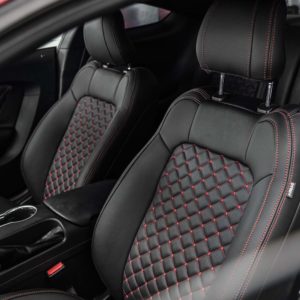There’s nothing quite like the feeling of getting stuck to your car seat on a hot day. The discomfort, the velcro-like sound of peeling your skin from the leather, it’s all part of the experience. Car manufacturers have tried to solve this problem by offering ventilated seats in their luxury vehicles. But is it worth the extra money you need to shell out on purchase? Let’s find out.
How Do Ventilated Seats Work?
A series of fans and ducts installed inside the vehicle’s seats circulate air through the upholstery. Perforated plastic makes up the upholstery of these seats, which allows the air from the fans to stream through the holes in the backrest and seat. The fans usually draw air from under the seat, where the temperature is lower than the rest of the vehicle. This cools both the inside of the seat and the person sitting on it. Some ventilated seats blow air directly onto the seat occupant. To create an evaporative effect, other ventilated seats also suck air into the seat.
Newer vehicles have heated and cooled seats, which actually use cooled or heated air to provide comfort.

Advantages and Disadvantages of Ventilated Seats
Ventilated seats come with their own set of advantages and disadvantages to look at. It’s ultimately up to you to decide if ventilated seats are worth it.
Advantages
The most obvious advantage of ventilated seats is their cooling effect. Ventilated seats can help reduce body heat and prevent sweating on the hottest days of the year. By preventing sweat and body oils from saturating the fabric or leather, these seats can also extend the life of your vehicle’s upholstery. The seats ultimately make sitting for long periods of time a little more comfortable, and they can give a more luxurious feel to your vehicle just by being there.

Disadvantages
While they’re very useful for hot climates, if you live in a relatively cool or cold area, you might find that ventilated seats aren’t worth the investment. These seats can, after all, be quite costly thanks to the extra technology and engineering put into them. You can expect to pay an extra $1,000 to have them installed instead of standard seats. This isn’t even counting the cost of maintenance and repair that you’ll need to pay to maintain the seats throughout your vehicle’s life. They can also take a toll on your battery on longer drives, adding to the cost of repair should your battery give out.
In addition, depending on the type of ventilated seats you buy, you’ll likely notice a certain amount of noise when the seats are on. It’s always best to test-drive a vehicle with ventilated seats before committing to installing them, because noise levels can vary depending on the seats you buy.
Finally, in terms of cooling, it’s important to note that ventilated seats don’t cool quite as well as cooled seats. While both work by circulating air through the seats, cooled seats use refrigerated air, and as a result, they can cool quicker and drop the temperature in the seats farther than ventilated seats. In the ventilated seats vs. cooled seats debate, you’ll need to decide how much cooling you’ll need. Picking either won’t make much of a difference in mild climates but it will make a difference in warm to hot areas.
Which Vehicles Have Ventilated Seats?
If you’re looking for cars with ventilated seats, you’ll often find them offered by premium brands like Tesla, Land Rover, Ford, and Mercedes-Benz. These manufacturers also have them in their SUV lines. Less expensive brands like Toyota, Honda, and Mazda also offer ventilated seats for some of their vehicles.
Keep in mind that some manufacturers use the labels of cooled seats and ventilated seats interchangeably, so it’s always best to specify the exact kind of seats you’re looking for with your dealer.
Carmakers typically only offer ventilated or cooled seats in specific models. If you want ventilated seats in particular, you might have to ask for a list of vehicle models with those seats available. Now that you know more about them, you’ll be able to decide whether they’re worth the extra cash or not.
Any information provided on this Website is for informational purposes only and is not intended to replace consultation with a professional mechanic. The accuracy and timeliness of the information may change from the time of publication.




















